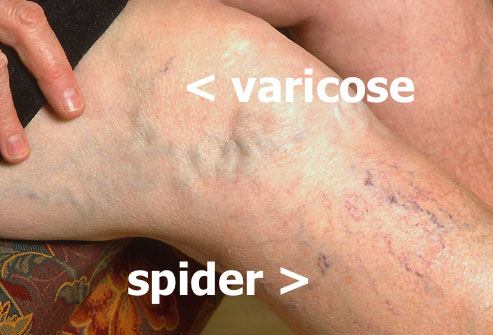When spider veins or varicose veins form on the legs you may not know for sure what they are.
The team at Vein Specialists of the Carolinas has a few tips to help you know what types of veins you are dealing with and how you can effectively treat both with minimal disruption to your daily life.
Spider Veins
Spider veins usually appear as red, purple, or blue networks of lines that resemble a spider’s web. These visible vessels are usually very small and within the skin layers. However, the networks of these veins can become cover large areas and be embarrassing in visible areas. They may sting, itch, pop or have a sharp shooting type pain. They may be associated with problems in deeper veins, especially if other symptoms like heaviness, aching tiredness, swelling, and itching are present. An ultrasound is required to diagnose the deeper problems. At their largest, they sometimes bulge just a little bit. The bulging part is very thin skin. If disrupted, these can bleed profusely. This usually occurs in spider veins in the lower leg and ankle area. Leg elevation and pressure are essential to get the bleeding to stop. Many people actually end up in the ER because they can’t get the bleeding stopped. The extensive blue veins around the ankle are also spider veins, but since they appear different are called a big medical name: “corona phlebectasia”. They are almost always associated with deeper vein problems.
Spider veins are caused by ineffective one way valves allowing blood to back flow into the tiniest of veins enlarging them until they are visible.
Treatment for spider veins can be performed at our office on an outpatient basis. We find sclerotherapy (injections) to be most effective. The tiniest needle made is used for these injections. One injection may treat lots veins in one area.
Many times spider veins are just a cosmetic issue and are not covered by insurance. Insurance will cover these when associated with the deeper vein problems and those problems are corrected. Also if bleeding occurs more than once or is profuse, they can be covered. We routinely look for these deeper problems and get insurance coverage the vast majority of the time. Many practices only take cash for spider vein treatment, even if there are deeper problems.
Varicose Veins
Varicose veins are larger than spider veins and do not appear in the same type of pattern. They originate just beneath the skin. They appear as bulging, flesh-colored ropes that make the surface of the skin bulge. Varicose veins and can be accompanied by the following symptoms:
- Aching or fatigued legs
- Swelling of the leg, ankle and foot
- Heaviness in the legs at the end of the day
- Leg cramps and restlessness, especially at night
- Skin burning or itching
- Changes to the color or texture of the skin around the lower inner legs or ankles
- Formation of open sores on the lower legs, known as venous ulcers
Varicose veins are caused by ineffective valves just like spider veins, just in larger veins. They are almost always associated with deeper vein problems.
Varicose veins can also form clots. This is called superficial thrombophlebitis or “phlebitus”. The veins become red, tender and hard. These are not dangerous like the Deep Vein clots (DVT) and virtually never go to the lungs. Phlebitis is associated with DVT in the same or other leg in about 15% of patients. Phlebitis is often mistaken as an infection and antibiotics may be prescribed. They do not help. The condition usually resolves or at least improves significantly by itself in a few days to weeks.
Treatment for varicose veins will eliminate both their appearance and their uncomfortable symptoms. They are treated by a minimally-invasive procedure known as microphlebec tomy, which removes them from the leg by very small puncture sized incisions. The incisions are so small no stitches are required and scarring is not visible. The vein is removed in sections. Sclerotherapy (injections) can also be used to treat varicose veins, but this often results in phlebitis which can leave brown staining of the skin.
Since varicose veins are almost always associated with deeper vein problems, they are nearly always covered by insurance once the deeper problem is fixed.
If you have spider or varicose veins, help is available. At Vein Specialists of the Carolinas we offer a variety of treatment options that can be tailored to your unique concerns and desired outcome. To learn more, contact Vein Specialists of the Carolinas in Gastonia at 704-861-2072 or in Charlotte at 704-544-5245.

